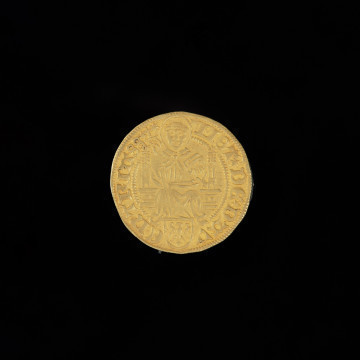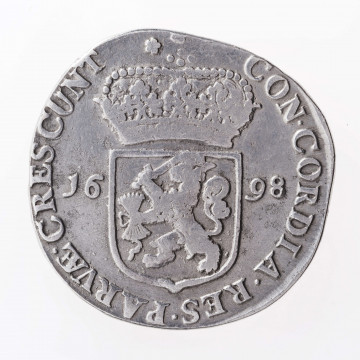
Gold guilder
1488
National Museum in Szczecin
Part of the collection: European and non-European coins
Gold or silver coins, whose value was based on the value of the bullion they were made of, could circulate even outside their country of origin, and some were often copied in neighbouring countries. Such money, characterised by identical weight and purity as the original, is not a forgery but an imitation. Imitating money was quite common in Europe. Among the most famous examples of this were copies of the gold English rosenobles, introduced in 1464 by Edward IV of York (1442-1483). The coin owes its name to the coat of arms of the House of York - the White Rose, visible on the side of the ship depicted on the obverse. The minting of the rosenoble was associated with the rise in the price of gold in Europe, which was more valuable in continental Europe than in England. As a result, English gold nobles were exported to Europe for profit, causing a shortage of gold in England. The introduction of the more expensive rosenoble was supposed to curb this phenomenon. The coin was not popular in England and was withdrawn after 1470. It remained in cicrculation in the Netherlands, where it was introduced in 1579 by Philip II of Habsburg (1527-1598). It was particularly valued there as a trading coin, and would see numerous imitations, which differ from the originals in terms of the inscriptions and details, such as coats of arms of Dutch cities on the banner of the ship and the shield held by the ruler, as well as mint marks. The presented coin was struck in Gorinchem, and it is almost identical to the coins of Edward IV. Not only does it have the correct titles of the ruler of England, but also the Latin inscription on the reverse: Then passing through the midst of them, He went His way. (Luke 4:30). The ship and text from the Gospel commemorate the victory of Edward III Plantagenet (1312-1377) over the French at the Battle of Sluys in 1340. The coin is an example of a large late medieval gold coin.
Mieszko Pawłowski
Other names
Rosenobel
Dimensions
cały obiekt: diameter: 38.2 mm
Object type
coin
Technique
minting
Material
gold
Creation time / dating
Creation / finding place
Owner
National Museum in Szczecin
Identification number
Location / status

1488
National Museum in Szczecin

1591
National Museum in Szczecin

1698
National Museum in Lublin
DISCOVER this TOPIC
National Museum in Lublin
DISCOVER this PATH
Educational path